INTRODUCTION
Admixtures are added to the concrete mix to reduce water content, accelerate or decelerate the setting property, make concrete light and modify concrete properties. They are added immediately before or during the mixing of concrete. Excessive amount of water may lead to excessive bleeding and segregation that is why admixtures are added to control such constituents of concrete. This imbalance makes the concrete weak and the strength will also be affected. Many admixtures provide the combination of Superplasticizers, plasticizers or air entrainers. In laboratories, the admixtures are added during concrete preparation but in field not much time can be given on mixing and making concrete appropriate for using quickly. Hence, admixtures are added in cement clinkers formation and then transported to the site for ready to use.
Earlier version of IS codes did not have design steps on special concretes but the new version i.e., IS 10262:2019 has all the details of design steps with admixtures to produce special concrete. Even solved examples for self-compacting concrete or high strength and high-performance concretes are there in the new version that shows how mix design can be done.
Admixtures can be of two types – natural and chemical admixtures. Natural admixtures include rice husk, egg mix, flour, ghee, etc. while chemical admixtures include GGBS, fly ash, pozzolana and so on. Earlier natural admixtures were widely used and the structures made with them still remains strong today, but the cost was the factor and not much modifications could be done with these. The use of chemical admixtures brough about variation in the construction industry that facilitated the production of self compacting concrete, high strength concrete, high performance concrete and so on, with the help of these chemical admixtures.
TYPES OF CHEMICAL ADMIXTURES
These are normally categorised as follows –
1. Plasticizers or water reducing agents
2. Superplasticizers or high range water reducers
3. Accelerators
4. Retarders
5. Air entrainers
6. Others
1. Plasticizers – These are used to improve the plasticity of fresh concrete by reducing water content without affecting the workability and water cement ratio. Types of plasticizers include calcium, sodium, ammonium lignosulphonates, polyglycol esters and so on. They are used in the amount of 0.1% to 0.4% by weight of cement. When these are added they get adsorbed on the cement particles. This creates repulsive force which is called zeta potential and it depends upon the amount of plasticizer used. Thus, the structure or texture changes from flocculated to disperse one and the trapped water inside the flocs gets released, that mixes and fluidifies. The plasticizers that are adsorbed on the surface of cement particles restrict the hydration of cement. The plasticizers decrease as the polymer gets entrapped in hydration products. Not only that, they increase the slump of concrete mix. They also have the capability of reducing water content upto an extent of 10%. They improve ability of pumping and maintain strength without effecting the structure.
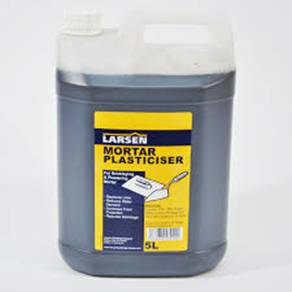
Fig 1: Plasticizer
COURTESY: LARSEN BUILDING PRODUCTS
2. Superplasticizers– They are chemically different from plasticizers. It has similar properties as that of plasticizerbut is more enhanced and is widely used in production of high strength concrete. Superplasticizers should be added just before placing otherwise a rapid loss of workability is observed when these are added to produce flowing concrete. C3A, which is a constituent of cement, has major influence on superplasticizers. Higher dosage of superplasticizers facilitates finer cement content that helps in producing high strength concrete, self-compacting concrete and high-performance concrete. Superplasticizers have the capability of reducing water content upto the extent of 20% to 40%. With increase in superplasticizer higher molecular mass can be observed. They have the capacity to
- Produce much more workable concrete maintaining same water-cement ratio.
- Produce same workability for low water-cement ratio.
- Reduce cement content by lowering water cement ratio thereby increasing strength.
Some examples are – naphthalene sulphonates formaldehydes condensates, modified lignosulphonate, sulphonated melamine formaldehyde and so on.
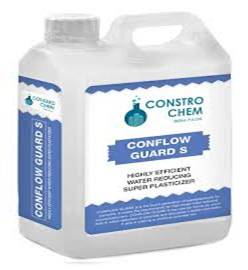
Fig 2: Superplasticizer
COURTESY: CONSTRO CHEM INDIA PVT LTD
3. Air entrainers – Air entrainers induce air in the form of bubbles and distribute it evenly throughout the cement paste. They are used where resistance of concrete is to be increased for protection of concrete against freezing and thawing. In harsh and lean mixes, they make the concrete mix more workable. They are also used to reduce bleeding and segregation that damages the concrete. Their dosage can be estimated as- 1% of air may lead to 5% loss of strength. They make the concrete light and reduce the dead load of the structure. Whenever excessive air is induced then application of ground blast furnace slag and fly ash can reduce the air content.
Main types of air entrainers include animal or vegetable fats, salts of wood resin, sulphonated hydrocarbons and so on. Other uses of Superplasticizers include –
- Decreases the permeability in concrete.
- Increases resistance to chemical attack.
- Reduces aggregate content.
- Reduces heat of hydration.
- Makes the mix economic.
- Reduces alkali and aggregate reaction.
- Facilitates early placing and finishing.
- Reduces modulus of elasticity and unit weight of concrete.
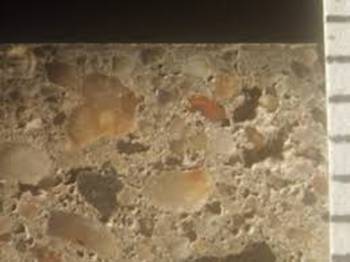
Fig 3: Air entrained concrete
COURTESY: BETON CONSULTING ENGINEERING
4. Accelerators–These admixtures speed up the setting property of concrete mix and result in early gain of strength. Rapid setting is required in case of marine structures or where fast pace of work is required for early completion of a structure. They are also used in cold areas where setting takes longer time than usual. Some examples of accelerators are calcium chloride, sodium chloride, sodium sulphite, sodium hydroxide, sodium carbonate, potassium hydroxide, potassium sulphate and so on. Among these, calcium chloride is not used in reinforced structure, and water-retaining structure. This is because it promotes of corrosion of steel and when reinforcement in concrete come in contact with air or water then it facilitates oxidation that leads to corrosion. Accelerators work effectively in low surrounding temperature.
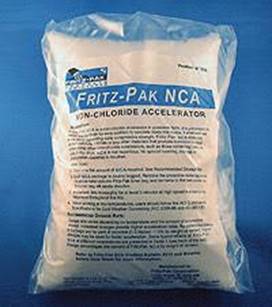
Fig 4: Chloride Accelerator
COURTESY: CONCRETE DÉCOR MAGAZINE
5. Retarders – These admixtures lower the setting property of concrete and slow down the chemical reaction between cement and water, leading to slow rate of gain of strength. Such retarders are used when cement mix is to be transported in distant places or in hot weather conditions where setting of concrete mix takes place quickly making it difficult to work or reduces workability. They are also used to prevent cold joints that occur because of duration of placing. Some examples of retarders are – sugar, lignin, hydroxylated carboxylic acids, phosphates, cellulose and so on. Some disadvantages of this includes that they increase plastic shrinkage often and result in cracking. Also, if addition time is delayed then retardation gets further extended.
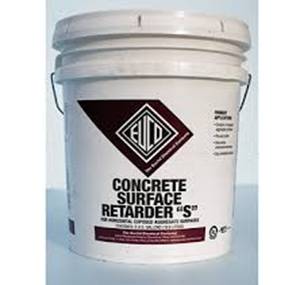
Fig 5: Retarder
COURTESY: CONSTRUCTION MIDWEST, INC
CONCLUSION
There are various admixtures that are available today and each one has different purpose for giving the concrete mix its desired properties. Their dosage is important as excessive amount can lead to disintegration of concrete and the strength and workability can get affected. However, less amount can lower its impact and not give the desired results. In addition to this as the codes for design mix are getting developed, more special concretes can be manufactured with such variety of admixtures.
REFERENCES
• Ramachandran, Vangi S., Handbook of Analytical Techniques in Concrete Science and Technology, 2001, ScienceDirect – https://www.sciencedirect.com/topics/materials-science/admixture#:~:text=Admixtures%20are%20ingredients%20that%20are,workability%2C%20increased%20strength%2C%20etc.
• Designing Buildings Wiki, “Admixtures in concrete”- https://www.designingbuildings.co.uk/wiki/Admixtures_in_concrete
• Shetty, M. S., “Concrete Technology theory and practice”, Seventh Revised Edition, S. Chand Technical.
If you have a query, you can ask a question here.


